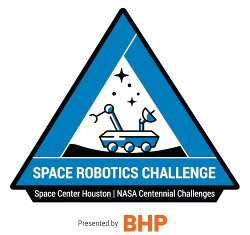 |
| SRC2 Rover |
Wheel Orientation
The orientation of the wheels on the rover determines the speed for the wheels. In straight or crab movement the speed is the same for all wheels. When turning, shown in the diagram below, the speeds are different for the inner and outer wheels. The requested overall speed of the rover, determined at the center of the rover, is used to calculate the inner and outer speeds.
| Term | Description |
| ICR | Instantaneous Center of Rotation |
| Rr | Radius from ICR to center of rover |
| Ri, Ro | Radius of rover's inner (i) and outer (o) sides through ICR |
| Wb, Wt | Wheel base and wheel track of rover. Lengths are representative of actual size. |
| WRi, WRo | Radius of inner(i) and outer (o) wheels |
| δi, δo | Steering angle for inner (i) and outer (o) wheels |
Visualize on the diagram three concentric circles drawn from the ICR. One circle passes through the center of the rover while the others pass through the inner and outer corners, or wheels, of the rover. The second post calculated the wheel's turning radius as:
The rover radius is Rr, the distance from the ICR to the center of the rover.
The speed (Sr) and turn radius of the rover determine the time (Tr) to complete a full circle, as shown in the first equation below. The next equation calculates the speed of either set of wheels (WR) using the circumference of the respective circles. Subsequently, that equation can be simplified as shown in the formulations that follow.
Twist Calculation
The standard ROS movement command is the twist message. It contains two 3 dimensional vectors. One specifies the linear movement for the x, y, and z dimensions. The other specifies the orientation, also as x, y, and z, but meaning roll, pitch, and yaw respectively.
The calculations for steering orientation and speed are all based on the radius of the turn. That turn radius needs to be calculated using the X velocity and the Yaw from the message. Recall from post three that turning during a crab movement is not under consideration so the linear Y value is ignored.
Getting to how to do the calculation requires some interesting analysis but the final, actual calculation is extremely simple. The starting point is the Yaw in radians / second. The first equation determines the time it would take to turn a full 2𝜋 radians at the Yaw rate. Or, how long to traverse a full circle.
Next, that time is used to determine the circumference of the circle using the X speed. Knowing the circumference the radius is determined. The equations show the individual steps but then combine them to reduce them to a simple calculation. Everything should reduce to such simplicity. Note that dimensional units are included to assure the final units are valid.









